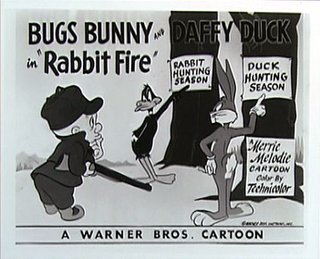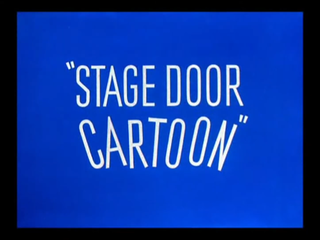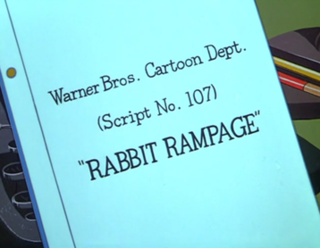
Duck Amuck is an American animated surreal comedy short film directed by Chuck Jones and written by Michael Maltese. The short was released on January 17, 1953, as part of the Merrie Melodies series, and stars Daffy Duck.

Merrie Melodies is an American animated comedy short film series distributed by Warner Bros. Pictures. It is the companion series to Looney Tunes, and featured many of the same characters as the former series. It originally ran from August 2, 1931 to September 20, 1969, during the golden age of American animation, though it had been revived in 1979, with new shorts sporadically released until June 13, 1997. Originally, Merrie Melodies placed emphasis on one-shot color films in comparison to the black and white Looney Tunes films. After Bugs Bunny became the breakout character of Merrie Melodies and Looney Tunes transitioned to color production in the early 1940s, the two series gradually lost their distinctions and shorts were assigned to each series randomly.

Rabbit Fire is a 1951 Looney Tunes cartoon starring Bugs Bunny, Daffy Duck, and Elmer Fudd. Directed by Chuck Jones and written by Michael Maltese, the cartoon is the first in Jones' "hunting trilogy"—the other two cartoons following it being Rabbit Seasoning and Duck! Rabbit, Duck! It is also the first cartoon to feature a feud between Bugs and Daffy. Produced by Edward Selzer for Warner Bros. Cartoons, Inc., the short was released to theaters on May 19, 1951 by Warner Bros. Pictures and is often considered among Jones' best and most important films.

A Wild Hare is a 1940 American animated comedy short film directed by Tex Avery, produced by Leon Schlesinger, and distributed by Warner Bros. as part of the Merrie Melodies series. The film was released on July 27, 1940, and features Elmer Fudd and Bugs Bunny, the latter making what is considered his first official appearance.

Elmer's Pet Rabbit is a 1941 Warner Bros. Merrie Melodies cartoon directed by Chuck Jones. The short was released on January 4, 1941, and features Elmer Fudd and Bugs Bunny.
Hiawatha's Rabbit Hunt is a 1941 Merrie Melodies cartoon directed by Friz Freleng. Mel Blanc voiced all characters. This film was nominated for the Academy Award for Best Short Subject (cartoons), but lost to Walt Disney's Lend a Paw. This was the first Bugs Bunny cartoon directed by Friz Freleng. The short makes several direct references to The Song of Hiawatha, an epic poem by Henry Wadsworth Longfellow.

Super-Rabbit is a 1943 Warner Bros. cartoon starring Bugs Bunny. The cartoon is a parody of the popular comic book and radio character Superman by DC Comics. Super-Rabbit was the 16th Bugs Bunny entry, and the 47th directed by Chuck Jones.

Rabbit Seasoning is a 1952 Warner Bros. Merrie Melodies cartoon directed by Chuck Jones. Released on September 20, 1952, the short stars Bugs Bunny, Daffy Duck and Elmer Fudd.

Duck! Rabbit, Duck! is a 1953 Warner Bros. Merrie Melodies cartoon directed by Charles M. Jones. The cartoon was released on October 3, 1953 and stars Bugs Bunny, Daffy Duck and Elmer Fudd.

Looney Tunes Golden Collection: Volume 1 is a DVD box set that was released by Warner Home Video on October 28, 2003. The first release of the Looney Tunes Golden Collection DVD series, it contains 56 Looney Tunes and Merrie Melodies cartoons and numerous supplements. The set won the Classic Award at the Parents' Choice Awards.

Bugs Bunny and the Three Bears is a 1944 Merrie Melodies cartoon short directed by Chuck Jones and written by Tedd Pierce. The short was released on February 26, 1944, and features Bugs Bunny. This short marks the first appearance of Jones' dysfunctional version of The Three Bears, and is a parody of the old fairy tale, Goldilocks and The Three Bears.

A Corny Concerto is a 1943 Warner Bros. Merrie Melodies directed by Bob Clampett. The short was released on September 25, 1943, and stars Bugs Bunny, Porky Pig, Elmer Fudd and Daffy Duck.

The Old Grey Hare is a 1944 Merrie Melodies cartoon directed by Bob Clampett. The short was released on October 28, 1944, and features Bugs Bunny and Elmer Fudd.

Stage Door Cartoon is a 1944 Merrie Melodies cartoon directed by Friz Freleng. The short was released on December 30, 1944, and features Bugs Bunny and Elmer Fudd.
Beanstalk Bunny is a 1955 Warner Bros. Merrie Melodies cartoon directed by Chuck Jones. The short was released on 12 February 1955, and stars Bugs Bunny, Daffy Duck and Elmer Fudd. The cartoon's story is derived from the fairy tale "Jack and the Beanstalk".

Rabbit Rampage is a 1955 Warner Bros. Looney Tunes animated cartoon, directed by Chuck Jones. The short was released on June 11, 1955, and stars Bugs Bunny.

Person to Bunny is a 1960 Merrie Melodies animated cartoon directed by Friz Freleng. The short was released on April 1, 1960, and stars Bugs Bunny, Daffy Duck and Elmer Fudd. It is the last cartoon to feature Arthur Q. Bryan as the voice of Elmer, and was released shortly after Bryan's death.

Elmer J. Fudd is an animated cartoon character in the Warner Bros. Looney Tunes/Merrie Melodies series and the archenemy of Bugs Bunny. His aim is to hunt Bugs, but he usually ends up seriously injuring himself and other antagonizing characters. He speaks in an unusual way, replacing his Rs and Ls with Ws, so he often refers to Bugs Bunny as a "scwewy" or "wascawwy (rascally) wabbit". Elmer's signature catchphrase is, "Shhh. Be vewy vewy quiet, I'm hunting wabbits", as well as his trademark laughter.
















